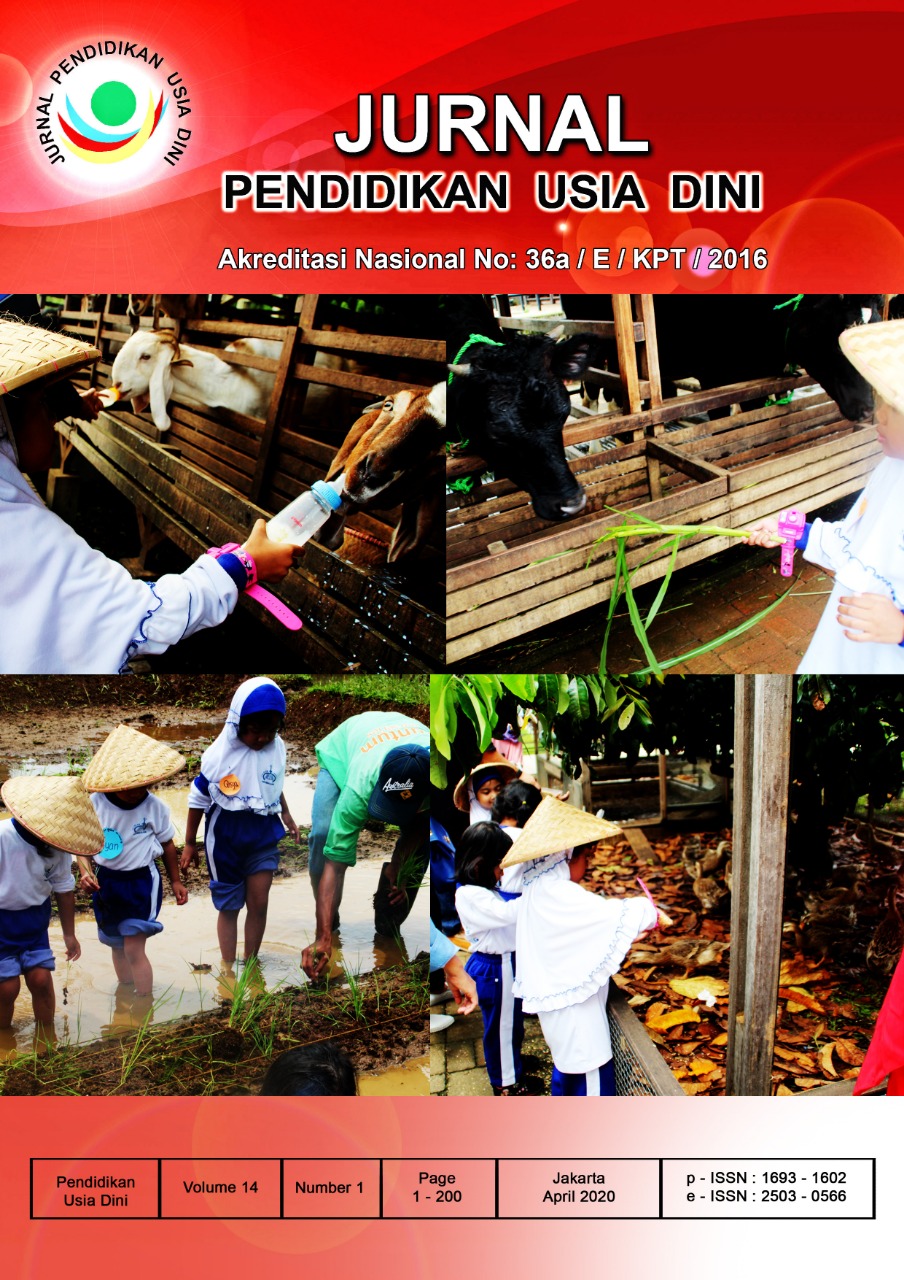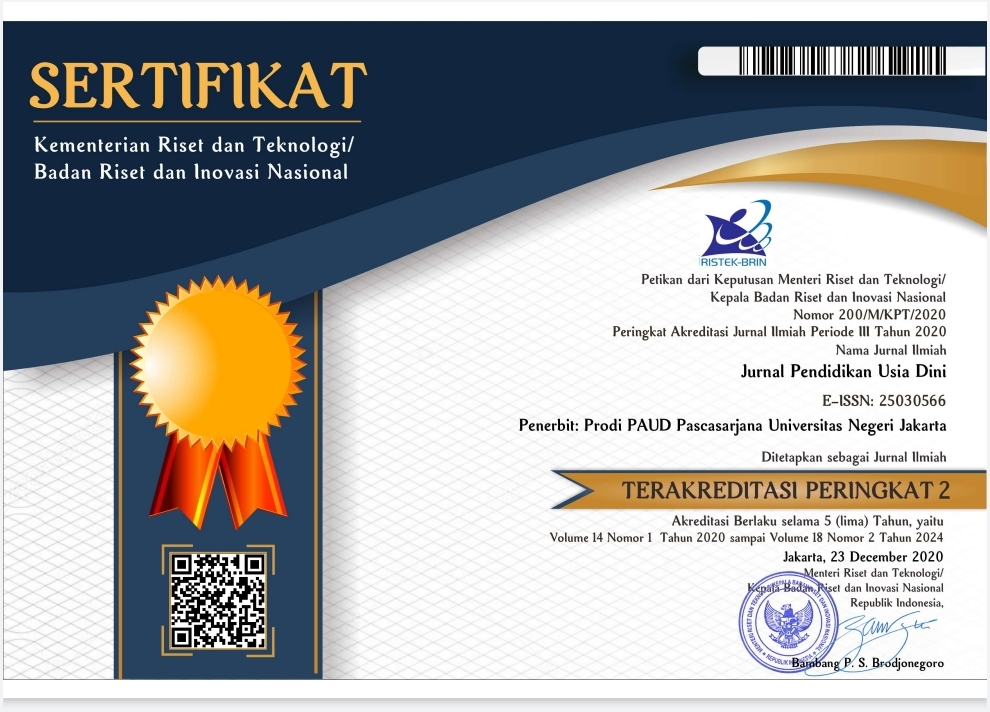Testing ICT-based Learning Model 'Creative Reading’ as A Trigger of Children’s Metalinguistic Awareness in Learning English
DOI:
https://doi.org/10.21009/JPUD.141.01Abstract
This 21st century is known as a period in which access to information and communi- cation technology (ICT) are widely open. This brings good in various fields, one of which is educa- tion. In relation to the use of technology in education sector, Kurniawan developed a learning model based on ICT that is a combination of the components of animation technology with aspects of Eng- lish learning specifically reading comprehension. The model is called Creative Reading Learning Model aiming to increase vocabulary understanding, concept and the use of previously owned knowledge. The model emphasizes the role of educators in preparing learning and students in under- standing learning through the help of animation technology that can arise prior knowledge to under- stand learning materials. This study aims to complete the Research and Development phase until the product is complete and analyze the pedagogical implications of the application of Creative Reading as a form of triggering metalinguistic awareness in the test group. Data obtained through observation. The results of this study indicate that children understand most of the vocabulary presented. Related to metalinguistic awareness, there are children who have used English intentionally with an under- standing of form and meaning as the basis.
Keywords: Creative Reading, English, Learning Models, Reading Comprehension, Vocabulary
Reference
Abdon, M. M., Maghanoy, J. M., Alieto, E. O., Buslon, J. B., Rillo, R. M., & Bacang, B. G. (2019). Phonological Awareness Skills of English As Second Language (Esl) Learners: the Case of First-Grade Filipino Bilinguals. Sci.Int.(Lahore), 31(5), 647–652.
Altman, C., Goldstein, T., & Armon-Lotem, S. (2018). Vocabulary, metalinguistic awareness and language dominance among bilingual preschool children. Frontiers in Psychology, 9(OCT), 1–16. https://doi.org/10.3389/fpsyg.2018.01953
Cadena, C. M. Z. (2006). Effectiveness of Reading and Improving Reading Comprehension in
Young ESL Readers (Universidad Del Norte Maestria). Retrieved from http://manglar.uninorte.edu.co/bitstream/handle/10584/718/45686016.pdf;jsessionid=E69 B0580514D369C34D96E4B48A8C9AC?sequence=1
Ceballos, M. R. S., Grenna, M., Joy, M., & Chall, J. S. (2012). Stages of Reading Development. Reading Difficulties and Dyslexia: An Interpretation for Teachers, 20–28. https://doi.org/10.4135/9788132108375.n3
Copland, F., Garton, S., & Burns, A. (2014). Challenges in Teaching English to Young Learners: Global Perspectives and Local Realities. TESOL Quarterly, 48(4), 738–762. https://doi.org/10.1002/tesq.148
de Souza, G. N., Brito, Y. P. dos S., Tsutsumi, M. M. A., Marques, L. B., Goulart, P. R. K., Monteiro, D. C., & de Santana, Á. L. (2018). The Adventures of Amaru: Integrating learning tasks into a digital game for teaching children in early phases of literacy. Frontiers in Psychology, 9(DEC), 1–8. https://doi.org/10.3389/fpsyg.2018.02531
Flemban, F. Y. (2018). Animated Pedagogical Agent’s Roles and English Learners’ Prior Knowledge: The Influence on Cognitive Load, Motivation, and Vocabulary Acquisition. University of South Florida.
Georgescu, C.-A. (2010). Using Blogs in Foreign Language Teaching. Educational Sciences Series, 62(1A), 186–191.
Guilford, J. P. (1977). Way Beyond the IQ. New York: Bearly Limited.
Karavas, E. (2014). Applied Linguistics to Foreign Language Teaching and Learning. An introduction to Applied Linguistics. In National and Kapodistrian University of Athens. Retrieved from http://opencourses.uoa.gr/courses/ENL6/
Kurniawan, M. (2012). Students’ Perspectives Toward the Use of Teacher’S Edublog in Efl Learning (Satya Wacana Christian University Salatiga). Retrieved from http://repository.uksw.edu/bitstream/123456789/3412/2/T1_112008013_Full text.pdf
Kurniawan, M. (2016). From Common Reading to Creative Reading: An ICT-Based ELL Model Development. Widya Sari, (March 2016). Retrieved from http://widyasari- press.com/index.php?option=com_content&view=article&id=756:from-common-reading- to-creative-reading&catid=92:vol-18-no-1-jurnal-maret-2016&Itemid=2
Kurniawan, M., & Tanone, R. (2016). Mobile learning in TESOL: A golden bridge for enhancement of grammar awareness and vocabulary mastery? Asian EFL Journal, 8(May), 155–159.
Li, L., & Wu, X. (2015). Effects of metalinguistic awareness on reading comprehension and the mediator role of reading fluency from grades 2 to 4. PLoS ONE, 10(3), 1–16. https://doi.org/10.1371/journal.pone.0114417
Masnan, A. H., & Ngajib, S. H. M. (2016). The Dilemmas of Teaching English in Cambodia Kindergarten. International Journal of Academic Research in Business and Social Sciences, 6(12), 190–196. https://doi.org/10.6007/ijarbss/v6-i12/2485
O’Brien, B. A., Habib, M., & Onnis, L. (2019). Technology-Based Tools for English Literacy Intervention: Examining Intervention Grain Size and Individual Differences. Frontiers in Psychology, 10(November). https://doi.org/10.3389/fpsyg.2019.02625
Robinson Anthony, J. J. D., Blumenfeld, H. K., Potapova, I., & Pruitt-Lord, S. L. (2020). Language dominance predicts cognate effects and metalinguistic awareness in preschool bilinguals. International Journal of Bilingual Education and Bilingualism, 0(0), 1–20. https://doi.org/10.1080/13670050.2020.1735990
Salazar, J. V. A. & Gallardo, F. O. R. (2017). Effectiveness of Reading Comprehension Activities for Developing Communicative Skills in 8th Basic Year Students at Unidad Educativa
Lemas. Universidad Laica Vicente Rocafuerte De Guayaquil.
Soesilo, T. D. et al. (2018). Konsep Dasar Perkembangan Anak Usia Dini. Salatiga: Satya
Wacana University Press.
Timothy, A. E. (2019). English Language Components Preference of Students in Calabar, Cross River State, Nigeria: Implications for Teaching English as a Second Language. SSRN Electronic Journal, (November). https://doi.org/10.2139/ssrn.3483857
Torgesen, J. K., Wagner, R. K., Rashotte, C. A., Herron, J., & Lindamood, P. (2010). Computer- assisted instruction to prevent early reading difficulties in students at risk for dyslexia: Outcomes from two instructional approaches. Annals of Dyslexia, 60(1), 40–56. https://doi.org/10.1007/s11881-009-0032-y
U.S. Department of Education. (2017). Reimagining the Role of Technology in Education: 2017 National Education Technology Plan Update. In Office of Educational Technology. https://doi.org/10.1080/09637498108430973
Downloads
Published
How to Cite
Issue
Section
License
JURNAL PENDIDIKAN USIA DINI work is licensed under a Creative Commons Attribution 4.0 International License. (http://creativecommons.org/licenses/by/4.0/)





